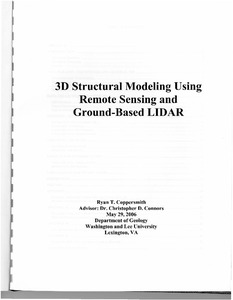| dc.rights.license | In Copyright | en_US |
| dc.creator | Coppersmith, Ryan Thomas | |
| dc.date.accessioned | 2023-10-20T15:49:32Z | |
| dc.date.available | 2023-10-20T15:49:32Z | |
| dc.date.created | 2006 | |
| dc.identifier | WLURG038_Coppersmith_thesis_2006 | |
| dc.identifier.uri | https://dspace.wlu.edu/handle/11021/36279 | |
| dc.description.abstract | High-resolution remote sensing data and 3D modeling techniques offer new
tools for structural analysis that improve on the efficiency, accuracy and precision of
geologic mapping, and provide insight into the structure of an area that is difficult to
obtain otherwise. I combine conventional remote sensing data and geologic mapping
with laser survey data into a complete 3D model that constrains the surface and
subsurface geometry of a part of the Catalan Coastal Range at the edge of the Ebro
Basin, Spain.
For lower relief areas two approaches are used to interpret orthophotos: I
interpret on orthophotos in map view and then visualize the interpretation in 3D by
draping the interpretation and photos over digital elevation models, secondly I
interpret directly on the draped orthophotos. I find the latter approach to be much
more accurate in interpreting the surface geology. In areas that are impossible to map
in a conventional sense with any precision, such as vertical cliff faces 100' s of meters
high, I employ 20 cm resolution ground-based LID AR. These data are of such high
fidelity that surfaces generated from the scans allow delineation of individual beds
that can be interpreted directly on the surface in 3D, similar to interpreting draped
orthophotos as discussed above.
To extend the surface interpretation into the subsurface I use a technique
exploiting the local 3D information of surface contacts with cross section
construction to ultimately build a self-consistent 3D model. For surface contacts that
have demonstrable relief change, a shallow subsurface 3D model is created. These
provide local structural control for cross-section construction. The cross sections are
then used as a framework for building of a 3D model. I found that making use of surface data in a 3D environment such as that described above provides additional
understanding of the structure of an area than cannot be obtained by conventional
mapping alone. | en_US |
| dc.format.extent | 51 pages | en_US |
| dc.language.iso | en_US | en_US |
| dc.rights | This material is made available for use in research, teaching, and private study, pursuant to U.S. Copyright law. The user assumes full responsibility for any use of the materials, including but not limited to, infringement of copyright and publication rights of reproduced materials. Any materials used should be fully credited with the source. | en_US |
| dc.rights.uri | http://rightsstatements.org/vocab/InC/1.0/ | en_US |
| dc.subject.other | Washington and Lee University -- Honors in Geology | en_US |
| dc.title | 3D Structural Modeling Using Remote Sensing and Ground-Based LIDAR | en_US |
| dc.type | Text | en_US |
| dcterms.isPartOf | WLURG038 - Student Papers | en_US |
| dc.rights.holder | Coppersmith, Ryan Thomas | en_US |
| dc.subject.fast | Geology, Structural -- Remote sensing -- Spain -- Catalonia | en_US |
| dc.subject.fast | Geological modeling | en_US |
| dc.subject.fast | Optical radar -- Observations | en_US |
| local.department | Geology | en_US |
